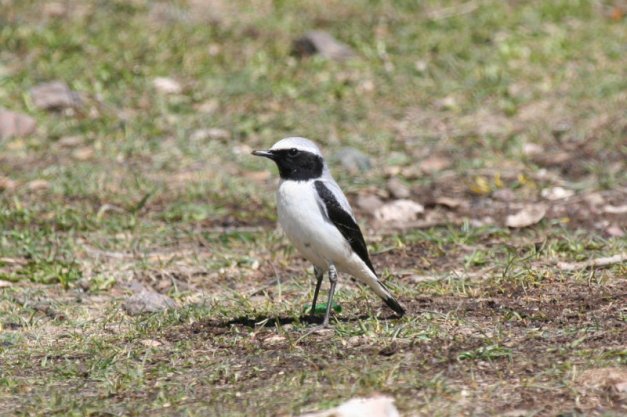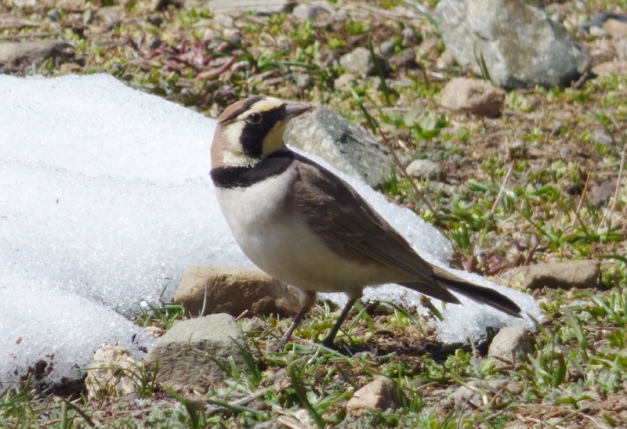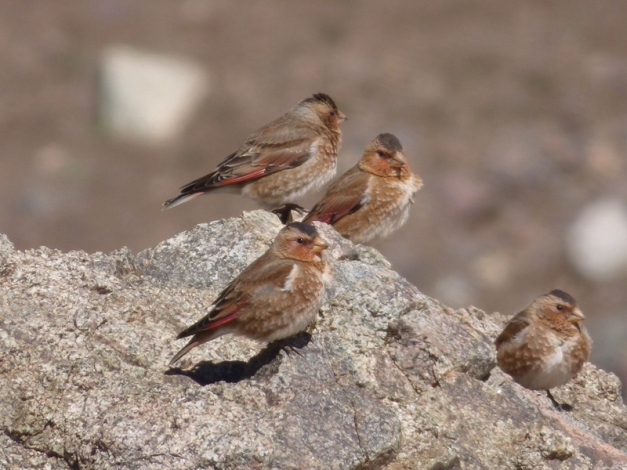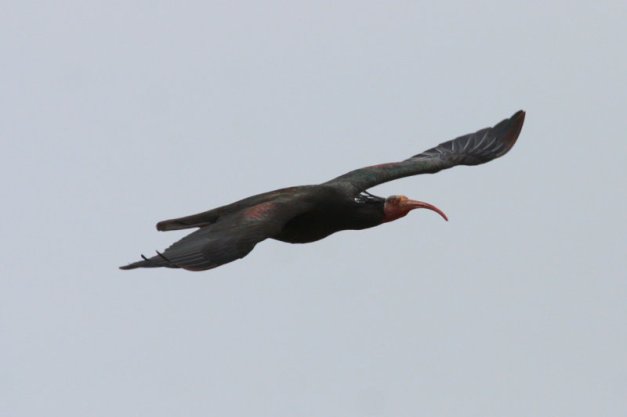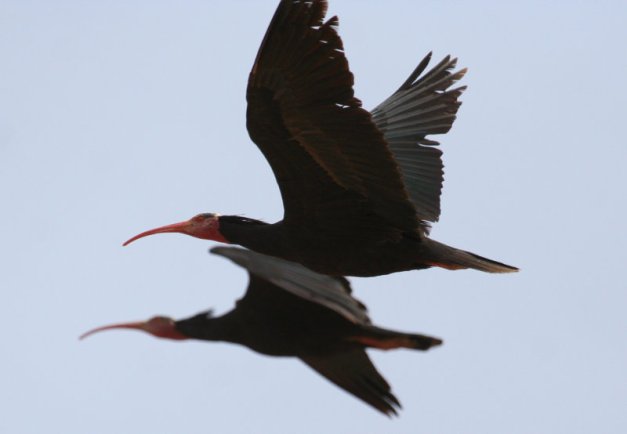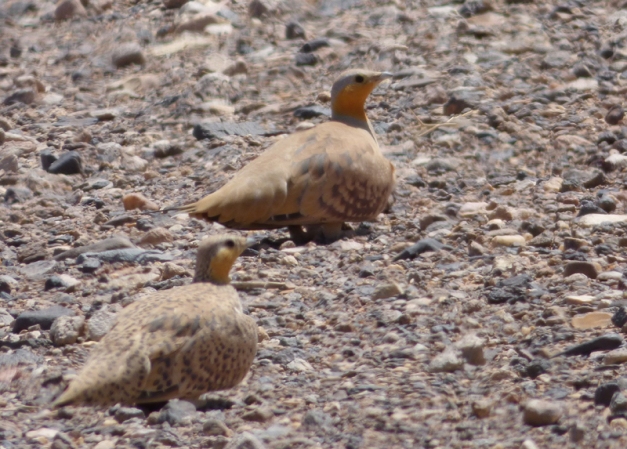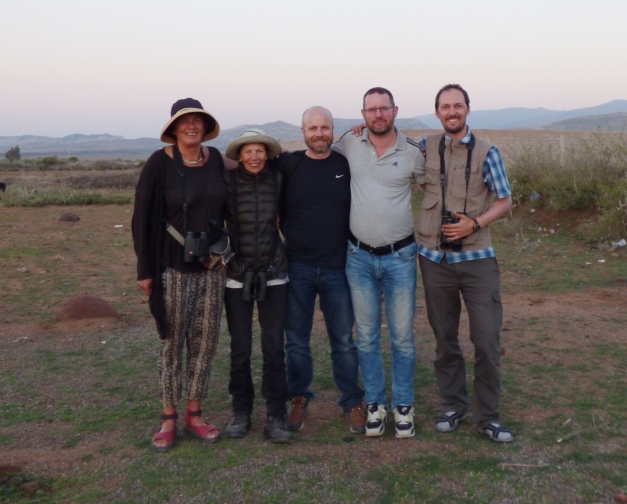Morocco: from Atlas to Sahara tour. 2016 issue
Dates: from April 1st to April 10th, 2016
Number of participants: 5
Number of species: 189 + 4 races
This is the official report of the 2016 issue Moroccan early spring trip by Barcelona Birding Point led by Carles Oliver. Our trip started this year in 1st April, some weeks later than in previous issues but having more or less the same itinerary.
Day 1. After a good breakfast in our hotel in Marrakech we head to the Atlas. Here the landscape becomes more wet than around the city and the valleys start to show river side forests along every single stream while the slopes around are covered by juniper scrub lands.
Our first stop in this ambient fastly produced the first birds of the trip. A pair of Great Spotted Woodpeckers (Dendrocopos major numidus) showed really well in the popplars. Right behind us we had 5 Hawfinches (Coccothraustes coccothraustes buvryi) showed out in the top of a close orchad tree. Some other birds around included African Chaffinch (Fringilla coelebs africana), Chiffchaff (Phylloscopus collybita), Blackcap (Sylvia atricapilla), European Serin (Serinus serinus), Greenfinch (Chloris chloris) and African Blue Tit (Cyanistes teneriffae ultramarinus), what a beauty!
Common Nightingales (Luscinia megarhychos) were singing around but we could not get any view on them, yet! Cattle Egrets (Bubulcus ibis) and White Storks (Ciconia ciconia) were all the time flying around while the firsts Red-rumped Swallows (Cecropis daurica) of many during the trip showed well flying over the orchads. Andreas spot also the first Grey Wagtail (Motacilla cinerea) of the trip calling from the top of a roof!
The main goal of the stop was, still, not hard to find out as a male Levaillant’s Woodpecker (Picus vallantii) was appearing along the tree line and showing really close. We all got excellent views on the bird moving along the tree and even drumming! What a bird!!
The African Chaffinch (Fringilla coelebs africana) is a common view in the Moroccan forests and it is also a possible future split. Image: Carles Oliver 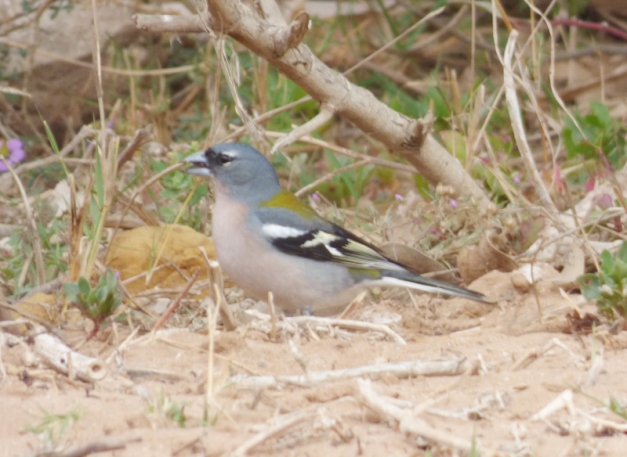
Levaillant’s Woodpecker (Picus vallantii), a scarce near-endemic living in the Atlas Northern slope. Image: Bauke Kortleve 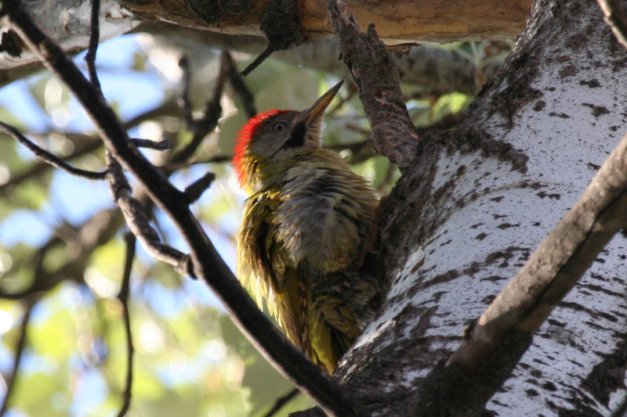
Our second stop of the day produced also a really good list of birds. Only after getting out of the car we got +4 Sardinian Warblers (Sylvia melanocephala) along with 5 migratory European Bee-eaters (Merops apiaster). Soon after we got excellent views on the local race of Subalpine Warbler (Sylvia cantillans inornata) singing and hiding, as tipically, really well, in the scrublands. A short walk in the area produced a Common Kestrel (Falco tinnunculus), a briefly seen pack of Barbary Partridges (Alectoris barbara), a male Cirl Bunting (Emberiza cirlus) singing from a perch,+4 Red-rumped Swallows (Cecropis daurica) and one wonderful Common Cuckoo (Cuculus canorus) singing from a really tall perch and flying away. But the best of the stop were the awesome views on Tristam’s Warbler (Sylvia deserticola) when a male came out from the bush land around. We were lucky as we could follow the bird among the vegetation for some minutes!!! This bird is also a Moroccan near-endemic and, well, sometimes not easy to spot.
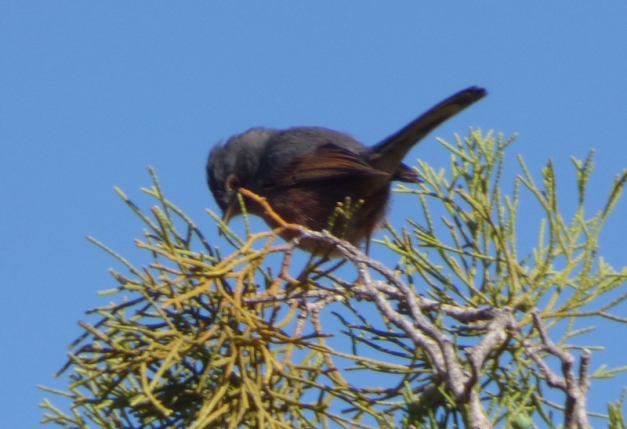
After that we just head to Oukaïmeden, the main stop of the day, since it is the best place for high mountain birds in Morocco. Still, even before arriving to Oukaïmeden we had to stop three times. The first spot to enjoy a flock of +8 Lesser Kestrels (Falco naumanii). The second stop produced a wonderful combination of raptors in the sky with both Long-legged Buzzard (Buteo rufinus cirtensis) and Booted Eagle (Aquila pennata) soaring over the slopes and a wonderful flock of over 40 Red-billed Chough (Pyrrhocorax pyrrhocorax). In the last stop we enjoyed a pair of light forms Booted Eagles (Aquila pennata) disturbed by Ravens (Corvus corax).
Once in Oukaïmeden we promptly had our first Common Rock Sparrow (Petronia petronia) and the near-endemic Seebohm’s Wheatear (Oenanthe seebohmi), counting over 20 of each of them at the end of our stay in Oukaïmeden. A flock of over 200 Alpine Choughs (Pyrrhocorax graculus) were flying over the opositte slope, impressive! A short walk around produced a good flock of Common Rock Sparrow and, alomg with them, Linnets (Acanthis cannabina), 2 Mistle Thrush (Turdus viscivorus deichleri) and our 3 Common Chaffinches (Fringilla coelebs) along the trip. Soon after Bauke spot the first Atlas Horned Lark (Eremophila alpestris atlas) of the day! Walking around we spot about 30 of them and didn’t have to wonder more to have our 2 firsts African Crimson-winged Finches (Rhodopechys alienus) showing close but briefly!! Still expecting a better views we walk a bit more further when Bauke spot, in a private moment, wonderful flock of 5 finches perched on a rock. What a view! This was to rank among the highlights of the trip!
Seebohm’s Wheatear (Oenanthe seehbomi), again a near-endemic living in the high mountain grass lands in Morocco and Algeria. Image: Bauke Kortleve
Atlas Horned Lark (Eremophila alpestris atlas), an endemic race (and possible future split) endemic of NW African high mountains. Image: Carles Oliver
African Crimson-winged Finches (Rhodopechys alienus) has been recently split from Asian Crimson-winged Finch. This was, of course, one of the highlights of the trip! Image: Carles Oliver
After a good lunch around we still enjoyed of the beautiful view of over 100 Choughs feeding on the grasslands around. They were mainly Alpine but some Red-billeds were providing really close views! A little walk further away still produced some really good birds. 1 Blue Rock Thrush (Monticola solitarius) was singing from the top of a ridge. Below, 4 Water Pipits (Anthus spinolleta) were feeding along the stream along with a pair of Grey Wagtails (Motacilla cinerea), Winter Wren (Troglodytes troglodytes) and Mistle Thrush. A wondwerful Rock Bunting (Emberiza cia) male was really celebrated in the group and gave us excellents while moving on ground. The last bird in appear up here was a distant but good view on a Dipper (Cinclus cinclus), a bird which has here its southermost population. Before coming back in our car, we still had 1 Booted Eagle in the sky.
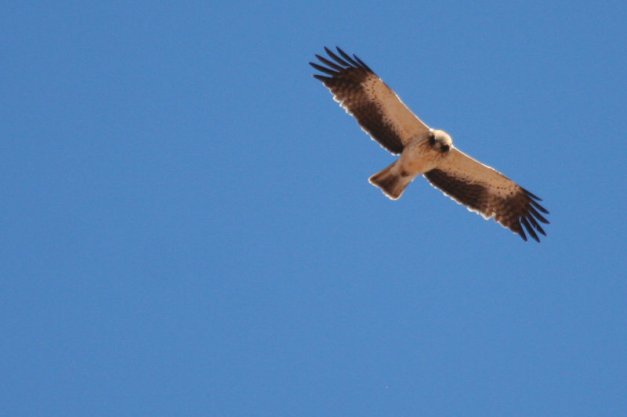
A new stop in a phantastic Spanish Fear (Abies pinsapo) spot produced some birds regarded to canopies. Coal Tits (Periparus ater) and Firecrests (Regulus ignicapilla) showed really well. A flock of 4 Siskins (Spinus spinus) was a really good bonus!
Lanner Falcon (Falco biarmicus), a gorgeous bird that we could enjoy up to 4 times along the tour. Image:Bauke Kortleve 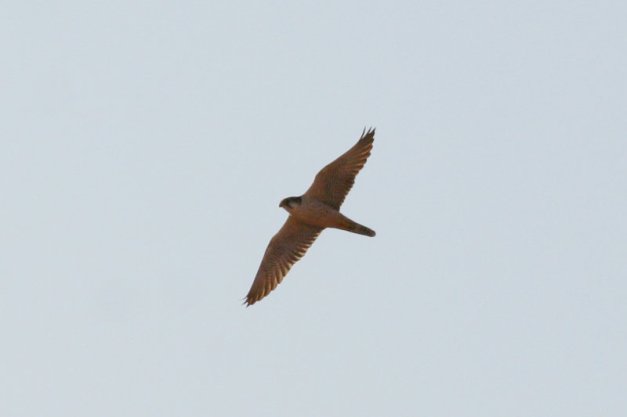
Day 2. An early morning start for our transfer to the area around Agadir. In our way we could see some flocks of European Bee-eaters in their migratory way and both Woodchat (Lanius senator) and Algerian Shrikes (this last a probable future split from Northern Grey Shrike).
Once arrived there we did a stop in the Tamri Stuary. From here we could see our 2 firsts Northern Bald Ibises (Geronthicus eremita) preening by the water. It was a far but really intense view because all the extremely delicated situation of this species worldwide! A fast view on the stuary produced a flock of 5 Eurasian Spoonbills (Platalea leucorodia), Grey Herons (Ardea cinerea), Little Egret (Egretta garzetta), 2 Ruddy Shelducks (Tadorna ferruginea) and a good flock of gulls and terns roosting on the beach.
We decided to do along the beach to have better views on the Ibises. Soon we discovered a pair of Kentish Plover (Charadrius alexandrinus) that provided excellent views along with Moroccan Wagtails moving on the beach while several Lesser Black-backed Gulls (Larus fuscus) were moving over us. During the walk we had at least 2 Subalpine Warblers (Sylvia cantillans) in the scrubs along the sandy area. When arrived closer to the stuary we had excellent views on the Ibises but also good views on +20 Audouin’s Gulls (Larus audouinii) sleeping on the beach along with +20 Sandwich Terns (Sterna sandvicensis) along with Yellow-legged Gulls (Larus michahellis), 2 Great Cormorant (Phalacrocorax carbo), 2 Common Ringed Plovers (Charadrius hiaticula) and Eurasian Coots (Fulica atra). In the way back to the car we had more views on Subalpine Warblers and a pair of flocks of Spanish Sparrows that had wonderful views on some males showing full summer plumage.
Not satisfied with the views we had on Northern Bald Ibises we went to explore the fields around expecting to find any group feeding on the sandy areas or going for water somewhere. After a short exploration we had some individuals flying around. Finally, we had at least 7 individuals moving on the slopes, feeding on ground and enjoyed of really close views of birds flying around us!!!
Above & below Northern Bald Ibises (Geronthicus eremita) flying in some of the really close views we enjoyed in Tamri. Images: Bauke Kortleve
These slopes are also great for other birds as we had at least 2 Spectacled Warblers (Sylvia conscipillata), Thekla Larks (Galerida theklae) and wonderful views on at least two pairs of Black-eared Wheatears (Oenanthe hispanica). Before leaving the area we had to stop again since a Long-legged Buzzard was soaring really close of the car, along with 1 Common Kestrel. Close by we also enjoyed 1 Peregrine Falcon (Falco peregrinus brookei).
Our next stop was in Cape Tamri, expecting to have some migratory sea birds. We did not do a long stay because of the strong (and cold) wind but still we had +100 Northern Gannets (Morus bassanus) flying North along with +3 Manx Shearwaters (Puffinus puffinus) and, the best, 1 Razorbill (Alca torda). This bird was my first Razorbill so far South, despite during this winter it had been some sights along this coast.
Last stop of the day was to explore the Souss River just beside Agadir. This really well known site is excellent to locate gull, terns and waders that cannot be located anywhere else during the trip! Before arriving we had some beautiful views on Laughing Dove (Streptopelia senegalensis) and Moroccan Magpie (Pica pica mauretanicus). The mudflats along the river had +30 Grey Plovers (Pluvialis squatarola), 1 Common Redshank (Tringa totanus), Curlew (Numenius arquata), 2 Whimbrels (Numenius phaeopus), several Eurasian Oystecatchers (Haematopus ostralegus), Common Ringed Plovers and good views on 5 Bar-tailed Godwits (Limosa lapponica), a pair of them showing a wonderful summer plomage.
There were several flocks of gulls in the mudflats. Scanning them we had 5 Mediterranean Gulls (Larus melanocephalus), 2nd year all of them, +15 Slender-billed Gulls (Chroicocephalus genei) and Black-headed Gulls (Chroicocephalus ridibundus) along with Yellow-legged and Lesser Black-backed Gulls. A big flock of over 50 Gull-billed Terns (Gelochelidon nilotica), some of them offering great views all around. Here we also had our firsts Zitting Cisticolas (Cisticola juncidis) of the trip. When arriving to our hotel we still had a wonderful view on a flock of over 40 Glossy Ibises (Plegadis falcinellus) flying over the area. Without doubt was an incredible end for our second day of the trip!
Day 3. Even before getting inside the car we already had a pair of really good birds. A pair of Moussier’s Redstart (Phoenicurus moussieri) was showing really well (and close) and, beyonf them, a pair of wonderful Stone Curlews (Burhinus oedicnemus) were sleepping in the bare slope. After a good view from the scope we just got inside the car and approached the birds, getting excellent views on them without disturbing them!
During the trip we had estremely close views on a pair of Stone Curlews (Burhinus oedicnemus) roosting just by one of our accommodations. Image: Carles Oliver 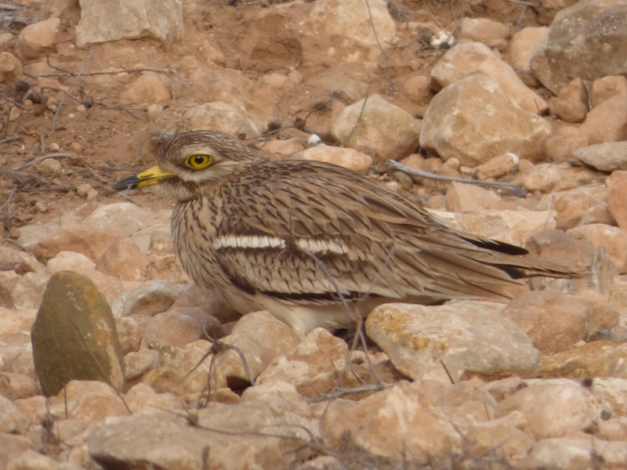
Our first stop in the morning produced an amazing range of birds. A small pond in the river Massa produced our Savi’s Warbler (Locustella naevia) and Little Crake (Porzana parva) listened in the reeds around. Here we also had good views on +3 Isabelline Warblers (Iduna opaca), Iberian Yellow Wagtail (Motacilla flava iberiae), 2 Cetti’s Warblers (Cettia cetti), 2 Western Bonelli’s Warbler (Phylloscopus bonelli), Sedge Warbler (Acrocephalus schoenobaenus), several Subalpine Warblers (Sylvia cantillans) and Blackcaps (Sylvia atricapilla) as well as commoner birds including Moorhen (Gallinula chloropus), Little Grebe (Tachybaptus ruficallis), African Chaffinch, Sardinian Warbler, Common Bulbul and several Laughing Doves (Streptopelia senegalensis). The area around was being highly productive and we could wish to do not move from there in the whole week!! We came out of the vegetation to have a better view on the pond when a Little Bittern (Ixobrychus minutus) appeared flying over the small pond. The bird was really celebrated although the best bird in the stop were two wonderful Black-crowned Tchagras (Tchagra senegalensis) appearing really close to us. We could enjoy of really close views on the birds while moving on ground and around us. What a start for the day!
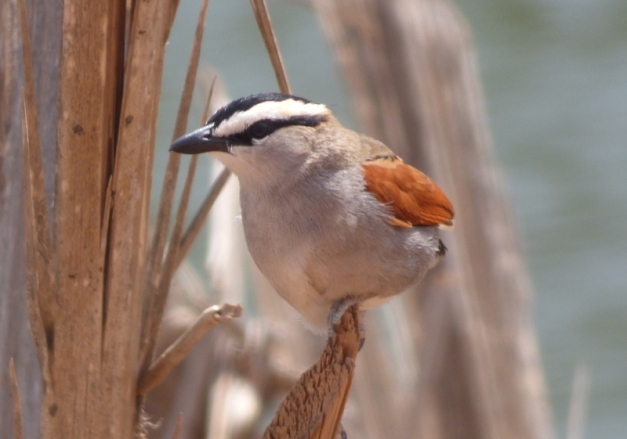
Moussier’s Redstart (Phoenicurus moussieri), a wonderful near-endemic that can be surprisingly common in some areas. Image: Carles Oliver 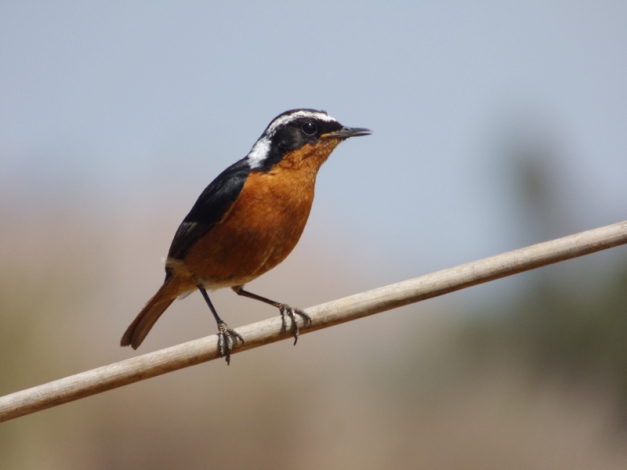
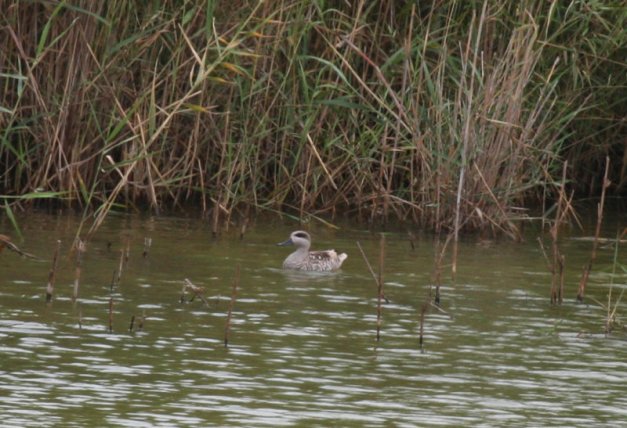
The transfer to our next stop produced wonderful views on a group of 4 European Bee-eaters (Merops apiaster) in the wires along the road. New stop, new pond. First sight here were two beautiful Black-crowned Night Heron (Nycticorax nycticorax) sleeping in a tamarisk with a wonderful Turtle Dove (Streptopelia turtur) singing right beside them. What a good combiation of birds! Grey Heron (Ardea cinerea) and Little Grebe were also present here.
In the fields around we spotted a pair of European Stonechat (Saxicola rubicola) and Corn Buntings (Miliaria calandra) while both Black-crowned Tchagras and more Turtle Doves were singing around us. A new Little Bittern was appearing from the reeds and flying over the pond but unfortunately we couldn’t relocated when stopping again among the vegetation. At the same time a Kingfisher (Alcedo atthis) joined the pond, stopping close to the Grey Heron. Again some Isabelline & Subalpine Warblers were moving by the edge of the reeds and our only one Purple Heron (Ardea purpurea) of the trip flew over us moving to the West…
Last stop of the morning. A tiny pond that was really productive for migratory birds. Again Subalpine Warblers and Blackcaps were moving here as well as Western Bonelli’s Warbler. A carefully scan of the area produced Isabelline Warbler, European Reed Warbler (Acrocephalus scirpaceus), Sedge Warbler, Willow Warblers (Phylloscopus trochilus), Cetti’s Warbler as well as 3 Squacco Herons (Ardeola ralloides), 1 Great White Egret (Chasmerodius albus), Common Sandpiper (Actitis hypoleucos) and Italian Yellow Wagtail (Motacilla flava cinereocapilla). The third Little Bittern (this time, a male) appeared from the lush vegetation! Here we also had the «rarity» of the trip; a Lesser Whitethroat (Sylvia curruca) showing really well, but rather shortly, in a tamarisk along with other warblers. This is a quite scarce bird in migration in West Europe and NW Africa so we can considered as the «best» bird of the trip! After such a successful morning we just came back to our accommodation for a good lunch and a bit of rest! During the afternoon we just travelled back to Marrakech after enjoying a bit of the dunes in the National Park.
Day 3. This day we were just crossing the Atlas to start exploring the Southern slope of this huge mountain range. But before and during the crossing we had some good stops.
First stop of the morning we did some birding in the olive orchads immediatly around Marrakech. Here we had some of the near-endemic Spotless Starlings (Sturnus unicolor) as well as several Common Bulbuls (Pycnonotus barbatus). Sardinian Warblers, African Chaffinches and Greenfinches we also present along with Africcan Magpies. Flocks of Little (Apus affinis) and Pallid Swifts (Apus pallidus) were flying over us. Here we had a good selection of migratory birds. Subalpine & Willow Warblers were common and we had also 2 Common Whitethroats (Sylvia communis) and Western Bonelli’s Warbler. The first of many Common Redstarts (Phoenicurus phoenicurus) were also showing out here and we also enjoyed the first Melodious Warbler (Hippolais polyglotta) of the trip showing really well in the out and even allowing good comparitions with both Willow and Isabelline Warblers!
Common Redstart (Phoenicurus phoenicurus) is a common (and beautiful) migratory bird in Morocco. Image: Bauke Kortleve 
The second stop of the trip was even more interesting. While driving the road up to Ourika Valley Bauke was having a new pack of Barbary Partridges by the road and a Black-shouldered Kite (Elanus caeruleus) was appearing in the sky. We stop, of course. We all had excellent, but short, views on the Kite flying around. Scanning the fields around we had a Short-toed Eagle (Circaetus gallicus) on a post. Also a really good bird. There, European Stonechats (Saxicola rubicola), Cirl Buntings, Zitting Cisticolas and Corn Buntings were all showing well.
A bird calling not far from us decided us to explore a bit further away, just at the moment that 2 Great Spotted Cuckoos (Clamator glandarius) were appearing, calling both of them, from the olive trees! We had great views on the birds flying and, after some wait, we had them also on a tree top, calling, preening and giving us a really good show!!
Great Spotted Cuckoo (Clamator glandarius), sometimes a tricky bird, gave us an excellent view and was considered as one of the highlitghs of trip by some members of the group. Image: Bauke Kortleve 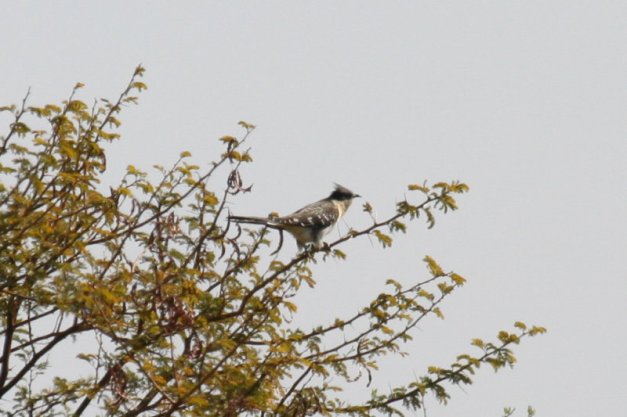
While driving up the Atlas we still had to stop a pair of time. The first because of a really close Short-toed Eagle flying over the car and the second because Andreas spot 2 European Rollers (Coracias garrulus) on a wire just by the road. Those birds gave us excellent views (and shots) during a pair of minutes. After they were living we just came out of the car to enjoy the landscape and at this moment a small flock of 6 migratory? Lesser Kestrels (Falco naumanii) passed over us, flying North!
European Roller (Coracias garrulus) was an unexpected (and very wellcome) bird while crossing the Atlas. Image: Bauke Kortleve 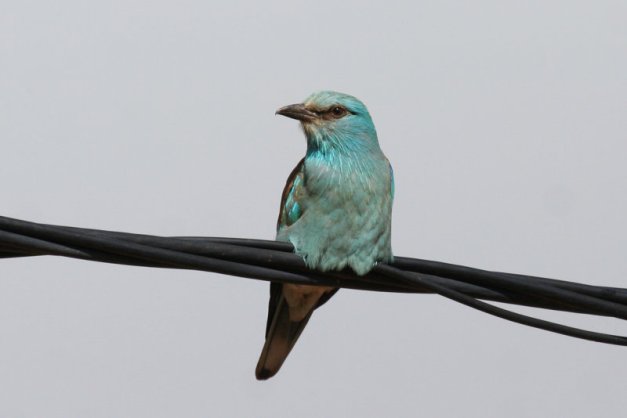
Moment to have lunch, and some birds. 2 Booted Eagles were flying over the terrace while waiting to be served. Around the restaurant 1 Common Nightingale (Luscinia megarhynchos) was singing quite close so we decided to try to have a look on the bird. And what a look!! We could see the bird calling and singing during 5 minutes, extremely close (4 metres?). Not bad for be waiting in a restaurant!
This Common Nightingale (Luscinia megarhynchos) was the first of many of them during the trip. Image: Carles Oliver 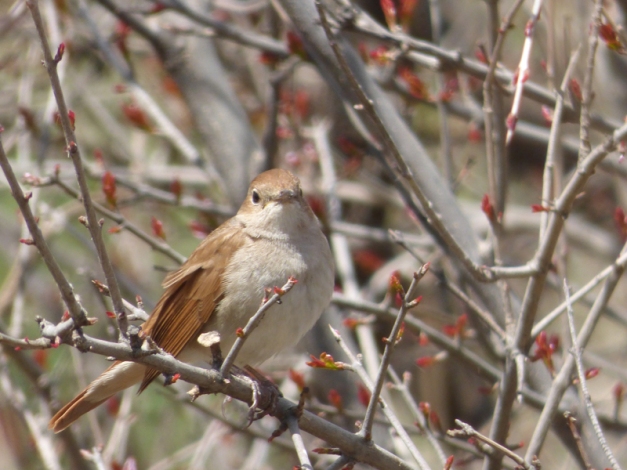
Our driving along the Atlas still gave us some more birds. Louise spot 2 Ravens and 1 Long-legged Buzzards. We did a pair of stops expecting to have, soon or later, some migratory raptors. Unfortunately we had nothing and our only migratory success were over 25 European Bee-eaters and a big flock of +100 Western House Martins (Delichon urbicum).
Once in the Northern slope we did a first stop in a typical migratory area. Here we had close views on common migratory birds such as Subalpine Warblers (Sylvia cantillans), Western Bonelli’s Warblers, Woodchat Shrike and great views on 2 Western Orphean Warblers (Sylvia hortensis) skulking inside a tiny almond tree along with Great Tit. The bird was also really celebrated! This place also offered our first of many Maghreb Larks (Galerida macrorrhyncha), a recent split from Crested Lark.
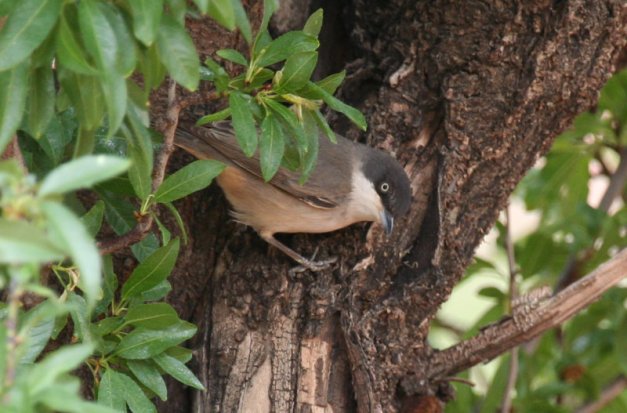
A last stop of the day was done along the road to look for the near-endemic, and very scarce, Maghreb Wheatear (Oenanthe lugens). After some scanning of the slopes around we got a really nice male up in the ridge of the cliff, moving in and out of some big hollows. What a bird! A probable female was also moving down in the slope but couldn’t be confirmed because of the wind and because the bird was disappering in the slope. We still had some more scanning trying to have better views but was impossible to relocate the birds and only got White-crowneds…
Stream in the Atlas Northern slope. This kind of ambients can be really productive. Image: Bauke Kortleve 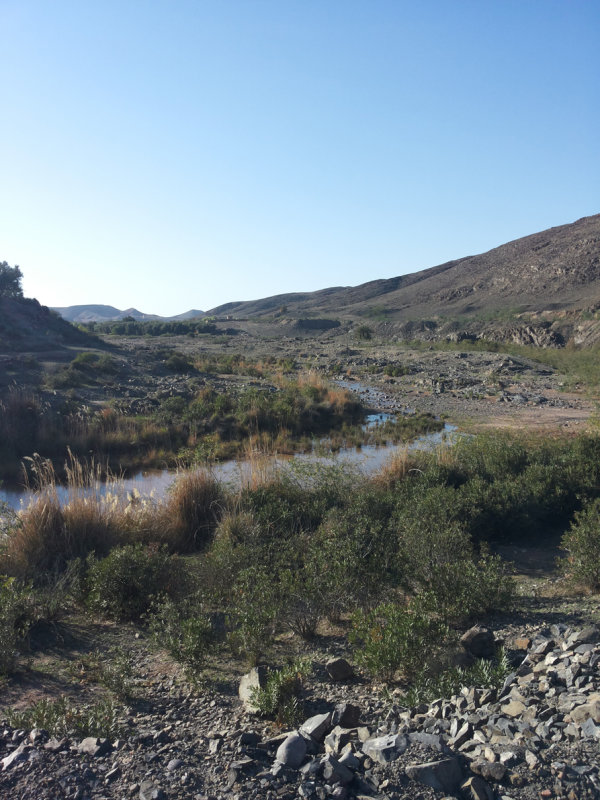
After such a good day we just did the short transfer to our accommodation, located in a wonderful oasis-like area. During the short transfer we still had a Common Redshank (Tringa totanus) and 1 British Yellow Wagtail (Motacilla flava flavissima) in some fields being irrigated as well as several Maghreb Larks and some family groups of White-crowned Black Wheatears were spotted as well as a pair of migratory Northern Wheatears (Oenanthe oenanthe) as well as our firsts Fat Sand Rats (Psammomys sp.).
Day 5. Early morning start and first scanning of the area around our accommodation. In the stream nearby we found 2 Little Ringed Plovers (Charadrius dubius) and 1 Green Sandpiper (Tringa ochropus) along with Grey Heron. A first stop in the steppes around produced 2 Desert Larks (Ammomanes deserti) and a first look on Desert Grey Shrike (Lanius excubitor elegans) despite the really, really strong wind…
The day before, by passing with the car, we just saw a good place with some water so we decided to do a stop there and enjoy the birds moving around. We had a good flock of over 20 Yellow Wagtails (mainly Iberian), 3 Little Ringed Plover, +4 Common Sandpipers and one pair of Ruddy Shelducks being this the first close view on this species so far.
After that we just went to the big dam immediatly South of Ouarzazate. Here, as always, there were tones of birds. Andreas spot 5 Eurasian Spoonbills roosting in the edge of the water while +100 Greater Flamingoes and +60 Glossy Ibises were feeding around. Here we also had our firsts Black-winged Stilt (Himantopus himantopus) as well as +15 Collared Pratincoles (Glareola pratincola) roosting in the mudflats. Other birds here include 1 Common Ringed Plover (Charadrius hiaticula) and our only one Dunlin (Calidris alpina) of the trip. Our only Calidris, actually…
Great White Egret, Little Egret, Grey Heron and Cattle Egret were all around the dam and 1 Gull-billed Tern (Gelochelidon nilotica) was also flying over.
Maghreb Lark (Galerida macrorhyncha), a recent split and a common bird in farm land ambients South of the Atlas. Image:Bauke Kortleve
Also in the mud around, several Yellow Wagtails were feeding… and along with them were pipits… I think the very first pipit we had that day was a meritory Red-throated Pipit (Anthus cervinus), being this species a scarce migratory bird in Morocco. At least 3 Water Pipits (Anthus spinolleta) were there along with the wagtails along with 2 Meadow Pipits (Anthus pratensis), a rather late birds.
Migratory birds were moving around and Bauke spotted the first Blue-checkeed Bee-eater (Merops periscus) of the trip and the unfortunately only sight on Montagu’s Harrier (Circus pygargus), a female. A small flock of Common Swift (Apus apus) was also moving here along with several House Martins and Sand Martins (Riparia riparia) and some beautiful Red-rumped Swallows (Cecropis daurica).
On the water, huge flock of +200 Red-knobbed Coot (Fulica cristata) gave us good views and a distant Great Crested Grebe (Podiceps cristatus) was a good bird to add to the bird list of the trip. Around the water, in the tiny riparian vegetation we had a Chiffchaff moving on ground as well as the most strange sight on Savi’s Warbler (Locustella luscinioides) I’ve ever had. The bird was clearly nervous and moving in the open, showing really well despite the really strong light. It was moving also on ground for a while, a behaviour quite common, but normally impossible to see in the field.
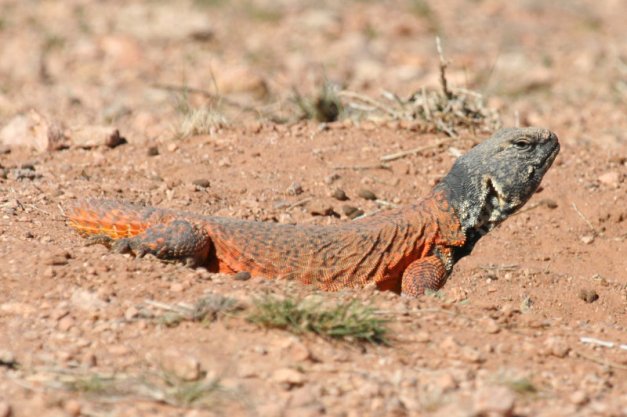
After arrived to our accommodation in Boulmane du Dades, we still had the afternoon to enjoy the famous Tahdild Road. That afternoon we had our firsts sights of many Temminck’s Lark (Eremophila bilopha), a wonderful, beautiful bird for me. We had also our only 2 Cream-coloured Coursers (Cursorior cursor) in a long, wonderful sight of the birds running in the steppe-lands. 1 Thekla Lark (Galerida theklae) was also showing well and we had our firsts 2 Thick-billed Larks (Rhamphocoris clotbei) flying over the steppes. Unfortunately only Gerda had them along with me so the next day our goal was to find a better ones!
Day 6. Full day in the steppe-lands around Boulmane and also some time to enjoy the Gorge du Dades. A first stop in the steppe land immediatly around Boulmane produced 3 Red-rumped Wheatears (Oenanthe moesta) and wonderful views on +6 Trumpeter Finches (Bucanetes githagineus) along with with Thekla, Temminck’s and our only one Greater Short-toed Lark (Calandrella brachydactyla) of the trip. 2 Seehbom’s Wheatears and 2 Woodchat Shrikes were a nice bonus, especially the wheatears!
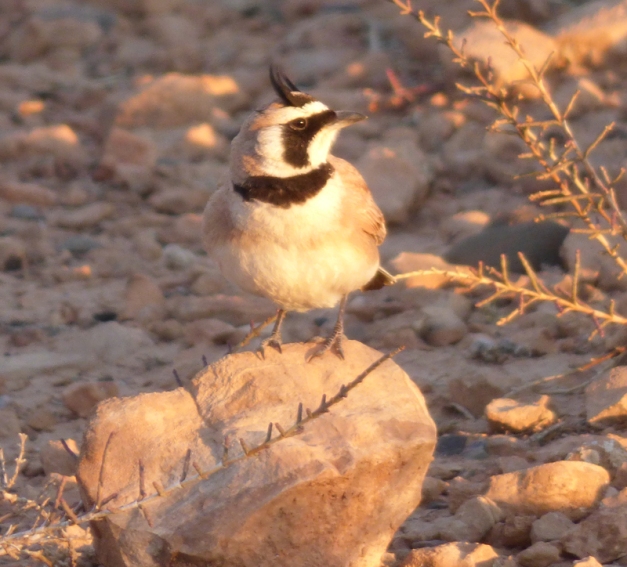
A second stop around produced +3 Desert Wheatears (Oenanthe deserti) and wonderful views on Lesser Short-toed Larks (Calandrella rufescens) & Fat Sand Rats. 1 Long-legged Buzzard was moving around and he had good views on the bird while perched in the steppe. 4 more Trumpeter Finches were also a good bonus here.
Third stop, this time in a good corner for larks and sandgrouses. We walked along one «stream» and got really nice views on Desert Wheatears and a favolous male of Thick-billed Lark (Ramphocori clotbei) that Andreas spot moving on the sand. We all enjoyed really good views on the bird while typically moving in the open areas, looking for food. As always, several Temminck’s Larks were also around and, when coming back to car, we still had a wonderful Wryneck (Jynx torquilla) moving on ground and providing us with really good views while following it!!
In this issue we have had, again, wonderful views on Thick-billed Larks ( Ramphocoris clotbei) being this male the first we had on ground. Image: Bauke Kortleve 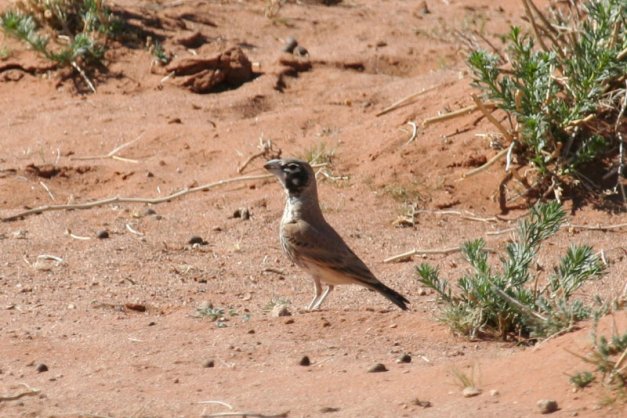
After lunch and some rest we just went around to explore one gorge just by Boulmane. Here we start to scan around when, suddenly, the impressive call of a Pharaon Eagle Owl (Bubo ascalaphus) came to our ears. The bird was really, really close so we just ketp slowly moving and scanning around until Bauke was finding the bird in a hollow in the cliffs! We all enjoyed the bird while sleeping and calling every 4-5 minutes… What a view!!
Pharaon Eagle Owl (Bubo ascalaphus) at its roosting place. It is wonderful to remember it singing among the rock while sleeping! Image: Bauke Kortleve 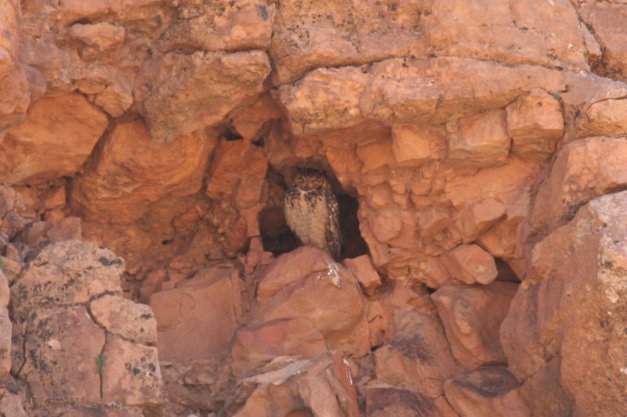
In the gorge around we also had some other birds including Common Kestrel, White-crowned Black Wheatears, Crag Martins (Ptynoprogne rupestris) and Desert Larks that showed really well and allowed really close views! An impressive Bell’s Dab Lizzard (Uromastyx nigriventris) was also a good bonus for all the group.
Desert Lark (Ammomanes deserti), a common bird living in semi-desertic areas. Image: Carles Oliver 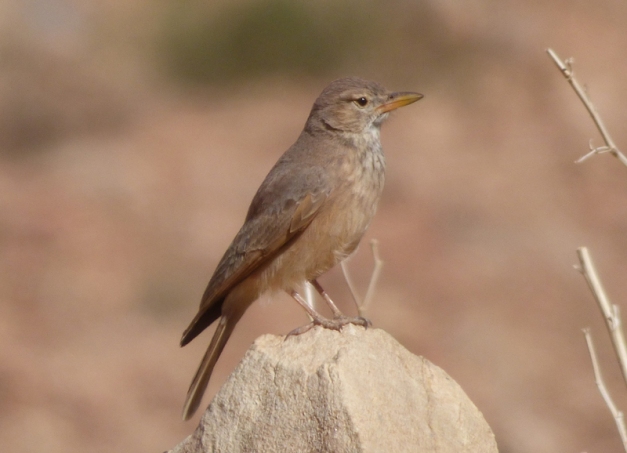
After that we still had some time to explore the Gorge du Dades. A first stop here looking for a better view on Barbary Partridge produced nothing at all… Despite this and along the road, we had some Blue Rock Thrushes and Black Wheatears as well as +10 Crag Martins (Ptynoprogne rupestris).
The next stop provided us with a distant but good view on a Barbary Falcon (Falco peregrinoides) right in the top of a cliff. The bird didn’t stole the show and after a pair of minutes just left the cliff to directly fly towards a really distant Booted Eagle that was on ground! After some fight in the air, the Falcon just left the area a second Booted appeared in the sky, stopping both of them on a dead tree up in the top of the cliff. A really different view from those I’m more used in the Pyrenees!
Still in our way back to the hotel we had to do a stop in the road since another Barbary Falcon was flying just over the car and did an incredible flight down chasing a small bird and losing itself in the palm orchards around the Dades River…
Black Wheatear (Oenanthe leucura) is a near-endemic bird living in cliffs and bare slopes. Image: Carles Oliver 
Day 7. Early morning start with the main goal to locate some Sandgrouses, a bird that was scaping us, so far. A pair of stops during the morning provide us with good looks to many interesting birds including +8 Red-rumped Wheatears, Desert Wheatears, Trumpeter Finches, Temminck’s Lark, Greater Short-toed Larks, 4 Long-legged Buzzards (including 2 juveniles) and 4 migratory Black Kites (Milvus migrans) but so signal of Sandgrouses any where…
Typical semi-arid countryside at the Southern slope of the Atlas mountains. Image: Bauke Kortleve 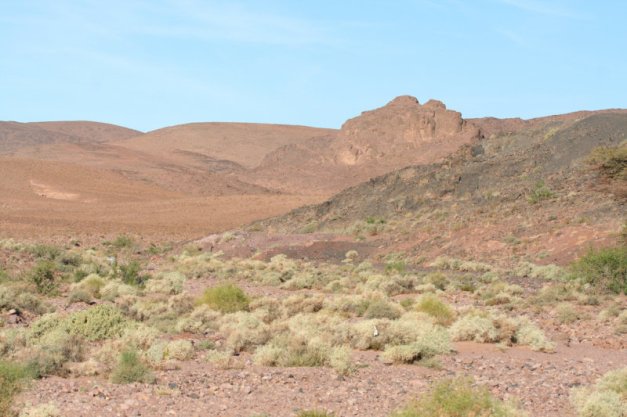
Finally we arrived to one place with some water… we didn’t have to wait for long until the first flock of Sandgrouses was appearing flying around! 4 Black-bellied Sandgrouses (Pterocles orientalis) showed their great way of flying! We decided to go closer to the water and had really close, wonderful views, on a pair of Black-bellieds, great! After some waiting there we could determine that at least 25 Black-bellied Sandgrouses were moving there in different flocks and we enjoyed of great views on some big flocks in the slopes around the water. Unfortunately we had to leave the area without signal of Crowned Sandgrouses (Pterocles coronatus), a bird that we finally missed during the trip, despite the many efforts to find one!
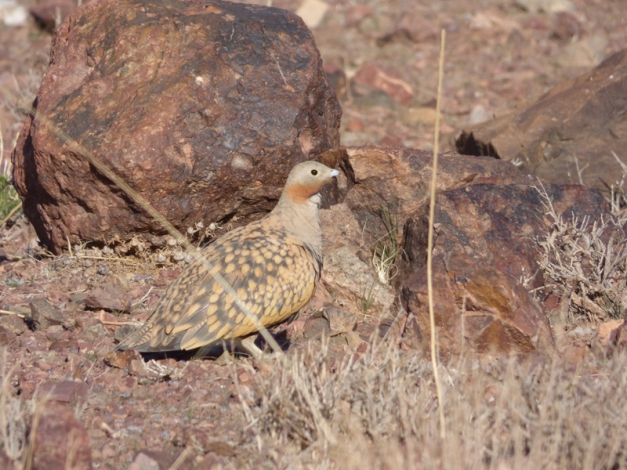
Male (left) and female (right) Black-bellied Sandgrouse approaching to a pool in the morning light. Image: Carles Oliver 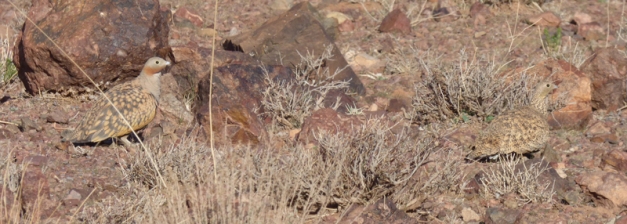
After such a wonderful encounter we just drove some mile East to explore a point where in 2015 we had Scrub Warbler. Unfortunately, a walk around only produced Spectacled Warblers, Woodchat Shrike, Maghreb Lark and a distant Lanner Falcon.
After lunch, we explore a second location for Scrub Warbler. A walk around was extremely productive. Along the ouadi (local name for the dry river beds in the desert and semi-desert) we had some flocks of Trumpeter Finch, Woodchat Shrike, 2 pairs of Spectacled Warbler, several Temminck’s Lark and one wonderful Thick-billed Lark moving around us!!
The scanning of the many scrubs around was not producing the desired bird until Bauke spot 3 Scrub Warblers (Scotocerca inquieta saharae) about 50 metres from us. It was probably a family group and the birds showed out for some seconds. We fastly moved there to re-scan all the area but unfortunately we couldn’t have again the birds. Still, when looking for them, we got again a distant Lanner Falcon and a really unexpected Bar-tailed Lark (Ammomanes cinctura) moving in the sandy area!! A good bonus, anyway!
This Bar-tailed Lark (Ammomanes cinctura) was a great surprise while scanning for Scrub Warblers. Image: Bauke Kortleve 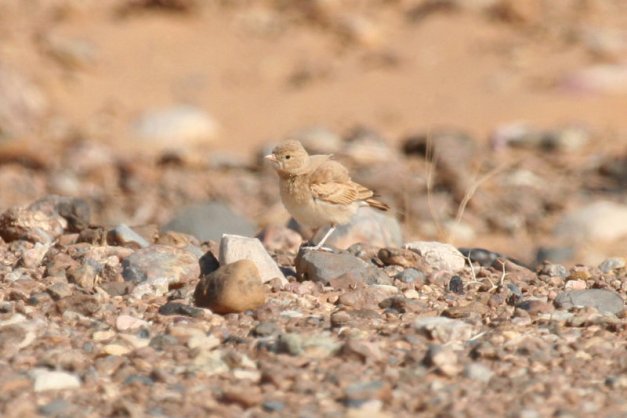
In our way down to our hotel in Merzouga we still had time to admire some of the many flocks of Blue-checkeed Bee-eaters moving in the oases along the road including some really close views!
Definately not a bad view on Blue-checkeed Bee-eaters (Merops persicus). Male and female that were also maiting by the car. Image: Carles Oliver 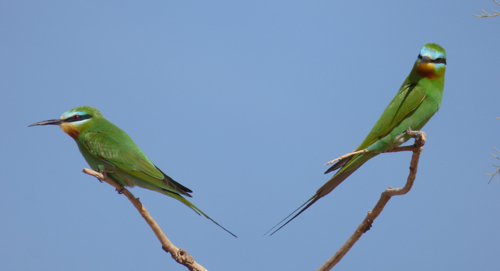
Day 8. Our day in the desert started in an excellent way. While waiting for some of the group, Gerda and I had a wonderful Lanner Falcon perched on ground directly in front of our hotel!! The bird just flew off and came to us, flying really close to the main building, going behind it and reappearing soon after joined by… a second Lanner!! Amazing!
The first stop of the day produced some typical migratory birds such as Common Redstart, Subalpine Warbler, Willow Warbler and European Bee-eater. Still, the main sight here was a phantastic pair of Desert Sparrow (Passer simplex) showing out really well while perched along with House Sparrows (Passer domesticus) or while looking for food in the dunes around… what a beauty!
Desert Sparrow (Passer simplex) was one of the highlights of the trip and we enjoyed of walk-away views on them. Image: Bauke Kortleve 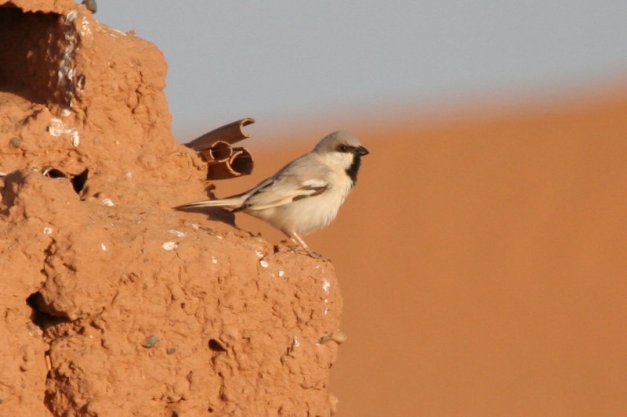
In our second stop that day we explore a «ouadi». Here we had our first of many (+8) Greater Hoopoe Larks (Alaemon alaudipes) that day. The birds were singing and displaying in a wonderful view, despite being a bit far away. Other birds here include Desert Grey Shrike, 3 Black Kites migrating North, Woodchat Shrike and 1 Greater Short-toed Lark. Still, no signal of the main goal in this stop… Some minutes later we had one of them calling and, finally, our local guide spot 1 African Desert Warbler (Sylvia deserti) about 200 metres «down» the ouadi. After a fast run towards the bird (and after a second running, actually…) we finally had really good views on one of the warblers (there were two moving around).
African Desert Warbler (Sylvia deserti) was finally appearing, despite required a long scanning (and some running!). Image: Bauke Kortleve 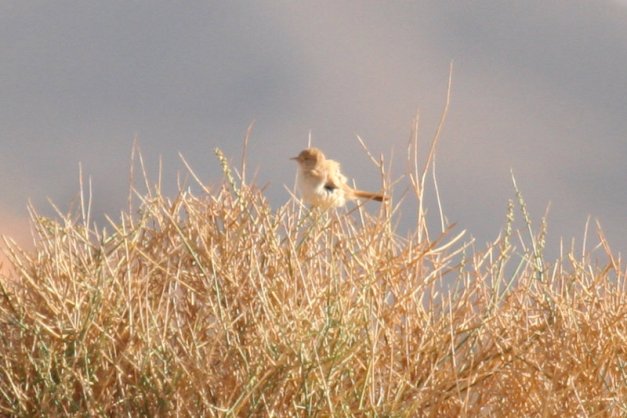
Happy for the good bird and the good exercise we came to the car. In the transfer we had some Brown-necked Ravens (Corvus ruficollis) flying here and there as well as several Barn Swallows (Hirundo rustica) flying North.
In our next stop we had 2 Egyptian Nightjars (Caprimulgus aegyptius) roosting on ground under the scarce vegetation of another ouadi. We, of course, had really long views on them and observed how they were oppening the eyes every minute or so, to check the area around… Other birds here included African Desert Warbler and Hoopoe Larks singing around and 3 Bar-tailed Larks! After some driving we also got 2 Spotted Sandgrouses (Pterocles senegalus) showing really close. It was also an excellent sight and very good for photographers in the group. After some more driving we had up to 8 Spotted Sandgrouses in different locations… Still, we didn’t get any Crowned, that was again the main goal of the driving.
Egyptian Nightjar (Caprimulgus aegyptius), again one of the highlights of the trip. This year we enjoy two birds while roosting. Below, Spotted Sandgrouses (Pterocles senegalensis), a «common» sandgrouse living in the desert. Images: Carles Oliver 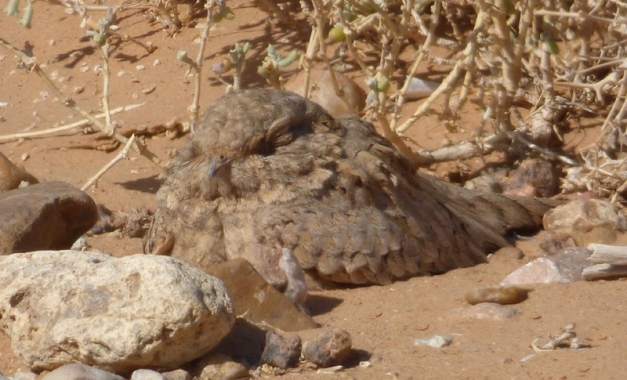
After a good lunch we just kept looking for birds. In the oasis-like areas we had several Maghreb Larks, Blue-checkeed Bee-eaters, Turtle Doves, Greenfinches, White-crowned Black Wheatears, House Buntings, Laughing Doves and Common Kestrels but probably the best birds there were 1 Little Owl (Athene noctua) roosting in a tiny cliff and two family groups of Fulvous Blabblers (Turdoides fulva) skulking really low and inside the low palm trees, moving on ground and performing their really characterystic calls. Again a wonderful bird! We just finished the day with some relax in our hotel and, who wanted, enjoyed also the Common Nightingale and even Orphean Warbler showing in the grounds of the hotel.
Day 9. Just when opening the door of my room that day I could see a good day was waiting for us since a Grasshoper Warbler (Locustella naevia) was right in front of me, 5 metres to me, moving in the open! Unfortunately I didn’t have my bins ready… well, I was not expecting such a sight!!! I have to say that it was the first of the day, but not the last. The first stop of the day was in an oasis-like area, just following a small stream surrounded by large tamarisks. Here we soon listened our first Saharan Olivaceous Warbler (Iduna pallida reiseri), a race that some argue as being a different species from Eastern Olivaceous. A minimum of 5 individuals were singing around and, after some carefully scanning of the canopies, we all had good views on the birds! Other birds moving here included also Isabelline, Willow, Subalpine & (many) Western Bonelli’s Warblers. Blue-checkeed Bee-eaters were flying around along with European Bee-eaters, a nice combination!
Rufous Bush Robin (Cercotrichas galactotes) was again one of the highlitghs of the trip and a bit unexpected sight due to the dates of the trip. Image: Carles Oliver 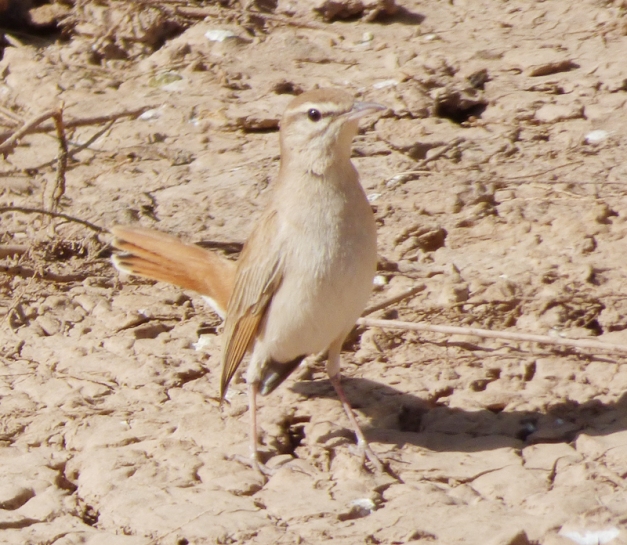
After spending quite a long time enjoying the birds in the stream we spent the rest of the morning trying to locate Crowned Sandgrouse around. Unfortunately we had no contact with this species althought we still got 2 Trumpeter Finches and really close view on 2 Hoopoe Larks and +30 Brown-necked Ravens, many of them really close.

Even before having lunch we had time to take a look into a pool in the desert. Here we had no big surprises out of Sedge & Eurasian Reed Warblers singing in the reeds, Little Ringed Plover and Little Grebe enjoying the water and 1 Marsh Harrier flying over…

During the afternoon we just did a walk in a forested land close to our hotel. This was probably one of the best spots in the trip… here we had +6 Common Redstarts moving along with both +2 Spotted (Muscicapa striata) and +5 Pied Flycatchers (Ficedula hypoleuca). We spent some time enjoying really close views on both Savi’s (Locustella luscinioides) and Grasshoper Warblers (Locustella naevia), both of them skulking in the vegetation and showing really close! Bauke spot two new Scrub Bush Robins moving on ground! Willow, Western Bonelli’s and Subalpine Warblers were all around us and we also got Turtle Dove and Eurasian Reed Warbler in the orchads. While walking in the area Louise spot a Golden Oriole (Oriolus oriolus) moving in the canopy. After several scanning we finally managed to have the birds (there were two!), first in a short flight and finally both of them flying up in the sky and moving to the North, hopefully expecting to arrive to South-West Europe in the next days!!
Laughing Dove (Streptopelia senegalensis), a common bird in the oases-like areas. Image: Bauke Kortleve 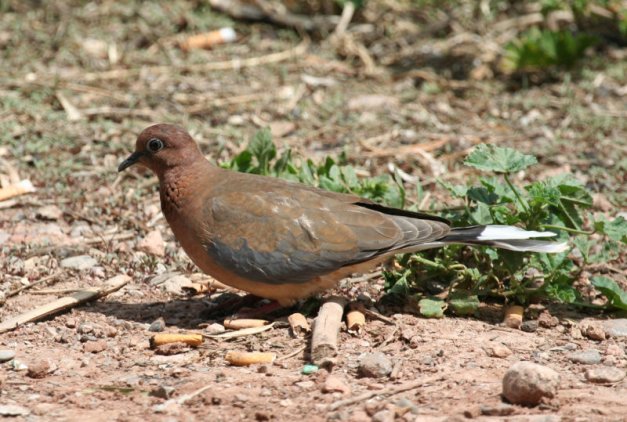
This was a really wonderful end of our really last birding day in the trip… I could personally be there for weeks but it was already dark so we came to our accommodation to have a good dinner and rest!
Day 10. The very last day of the trip was a long, but good, transfer from Merzouga to Marrakech. In the way up we still had some good surprises, like a wonderful Egyptian Vulture (Neophron percnopterus) flying really low over the car around Rissani! It is always nice to see them in Morocco, since there are really few left of them in the country…
White-crowned Black Wheatear (Oenanthe leucopyga) becomes a common view immediatly South of the Atlas mountains. Image: Bauke Kortleve 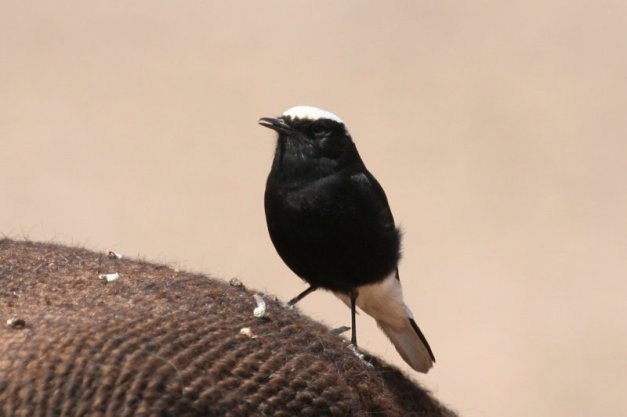
One stop after lunch produced several warblers. Out of the «normal» migratory birds down here we got again nice views on Western Orphean Warbler, Goldfinch and Saharan Olivaceous Warbler.
While crossing the Atlas we had a pair of stops to try to find some raptors. Again we were not really lucky and we only got a really distant eagle moving East. It was a Bonelli’s Eagle (Aquila fasciata) but unfortunately nobody in the group had good views on the bird. A second stop in the Atlas was more productive. Here we had African Chaffinch, Grey Wagtail, +5 Nightingale, Blackcap, Winter Wren, Great Tit, European Robin (Erithacus rubecula) and our only one Garden Warbler (Sylvia borin) of the trip! Probably the best birds in this stop were a gorgeous Booted Eagle, dark form, hunting in the fields around and 3 Hawfinches showing really well just by the road. Excellent!
The very last stop of the trip was in some open fields, no very far away from Marrakech. Here we had good views on Stonechat, Woodchat Shrike and a new Western Orphean Warbler was showing a bit far, but well, good views after all. The best bird was, still, the 4 Barbary Partridges enjoyed while moving on ground in the fields. This bird didn’t offer any good view during the trip so far so it was a wonderful end for the trip!!
When we finally arrived to our hotel we were a bit tired of the long trip but we really satisfied of the wonderful trip we had. Weather this year was perfect all the days and we all enjoyed a good group of birdwatchers with really interesting chatings about the natural and human history of Morocco…
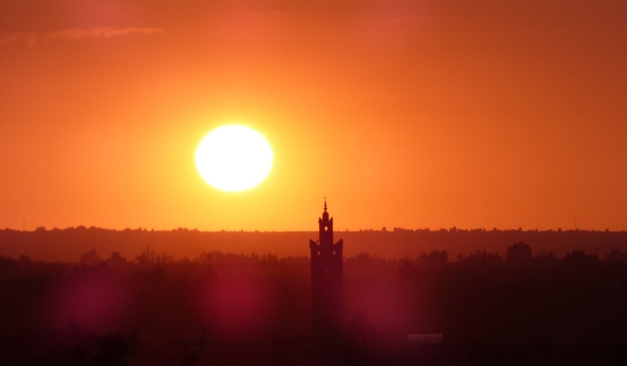
Sunset in Ourika Valley, in our very last stop of the trip… Image: Carles Oliver
Well, this was the trip… 2017 issue of the trip will run from 21st March to 30th March. Do you really wan to miss it?
You can have more images of the trip by following this LINK Many thanks to Bauke Kortleve for sharing his excellent images!!
To see the report of the 2015 issue please follow this LINK

